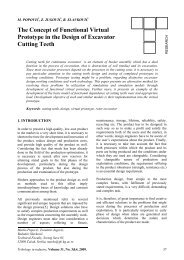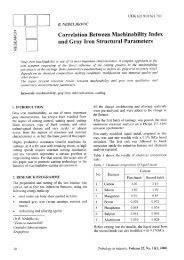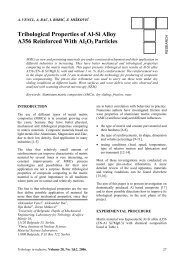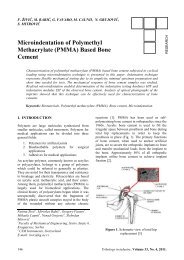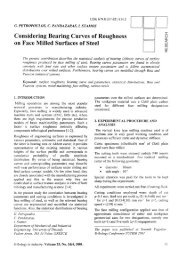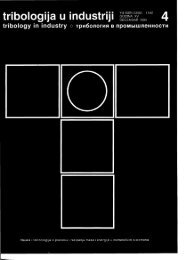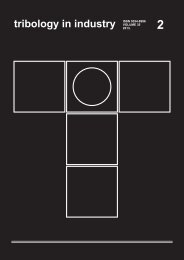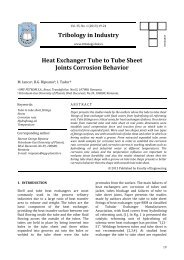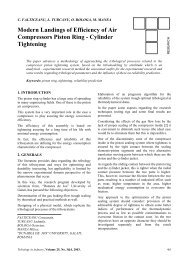Tribological Behavior of Thermal Spray Coatings, Deposited by ...
Tribological Behavior of Thermal Spray Coatings, Deposited by ...
Tribological Behavior of Thermal Spray Coatings, Deposited by ...
You also want an ePaper? Increase the reach of your titles
YUMPU automatically turns print PDFs into web optimized ePapers that Google loves.
A. Lanzutti at al., Tribology in Industry Vol. 35, No. 2 (2013) 113‐122The Ni electrodeposits showed, at roomtemperature, a triboxidation with a descaling <strong>of</strong>oxide which forms a third body between thecounter material and the wear track, thusleading to the formation <strong>of</strong> secondary tracksrelated to abrasive wear. At high temperaturethe coatings showed a strong triboxidation. ByEDXS analysis on pure Ni coatings, it wasdetected that during the wear test the steelsubstrate was reached. For the composite Ni/SiCcoatings it seems that the oxide produced ismore adherent to steel substrate at hightemperature. Probably both the grainrefinement and the presence <strong>of</strong> ceramic particlesare linking the oxide to the metal matrix. Itseems that some counter‐material wastransferred to the coating surface, due to slightadhesion phenomena.The wear rate <strong>of</strong> all tested coatings at both roomtemperature and 300 °C are shown in Fig. 7.temperature one and this could be related toboth high oxidation resistance <strong>of</strong> the materialthat contains a high amount <strong>of</strong> Cr and to thereduction <strong>of</strong> material detachment thatconsequently reduces the abrasive phenomena.The ceramic coating (Cr 2 O 3 ) showed a high wearrate at 300 °C tests due to phase change <strong>of</strong>chromium oxide under tribological contact.The electrodeposits showed good wearresistance at room temperature, higher for thenano‐composite coating. This reduction in wearrate could be related to the grain refinement <strong>of</strong>microstructure <strong>of</strong> the metal matrix, whichincreases also the mechanical properties <strong>of</strong> thecoating. This effect is not visible in the microcompositecoatings because the reinforcementparticles are usually detached from the metalmatrix leading to intensive abrasive wear caused<strong>by</strong> hard particle third body contact betweencounter material and surface <strong>of</strong> the specimen. Athigh temperature the mechanical behaviour <strong>of</strong>the coating is reduced, probably because <strong>of</strong> thehardness decrease. In this case the pure Nicoating is completely removed while the microcomposite coating showed a better wearresistance, compared to the pure Ni one, but thewear rate values were still higher than thethermal spray coatings wear rates. The higherwear resistance <strong>of</strong> the nano‐composite coatingat 300 °C is probably related to the highermechanical properties <strong>of</strong> the metal matrixcompared to the other electrodeposits.Fig. 7. Wear rates graph at both room temperatureand 300 °C for all the coatings tested.All the coatings protect the steel substrateduring the test, except for the pure Ni coatingthat showed, at 300 °C, the highest wear rate. Itis possible to observe that the cermet coatinghas the lowest wear rate compared to the othercoatings at both test temperatures. This isrelated to the high amount <strong>of</strong> WC which isbonded <strong>by</strong> a metal matrix that has highoxidation resistance at the test temperatures.For this coating the wear resistance is associatedto the carbide component and the particlesbinding is related to the metal matrix which hasa high toughness. On the other hand, the NiCrcoating showed a lower wear rate at hightemperature tests, compared to the roomIn Figs. 8‐9 the COF (Friction Coefficients <strong>of</strong> thetested materials) are shown. For all the testperformed on thermal spray coatings, it ispossible to observe that the COF values, at theend <strong>of</strong> the test, are comparable between thetests performed at different temperature, apartthe ceramic coating that showed a lower COF athigh temperature due to the change phase <strong>of</strong>ceramic oxide under hertzian loads. The NiCrcoatings showed a noisy COF graph because <strong>of</strong>the coating material detachment that producedabrasive particles that dissipated more energy,required to move the particles in the hertziansystem. At high temperature there is a start atlow COF and, at regime, it reached the samevalues <strong>of</strong> the test at room temperature. Probablyduring the start <strong>of</strong> the test the surface <strong>of</strong> thesample was covered <strong>by</strong> a oxide layer producedduring the heat up <strong>of</strong> the system. The presence119



